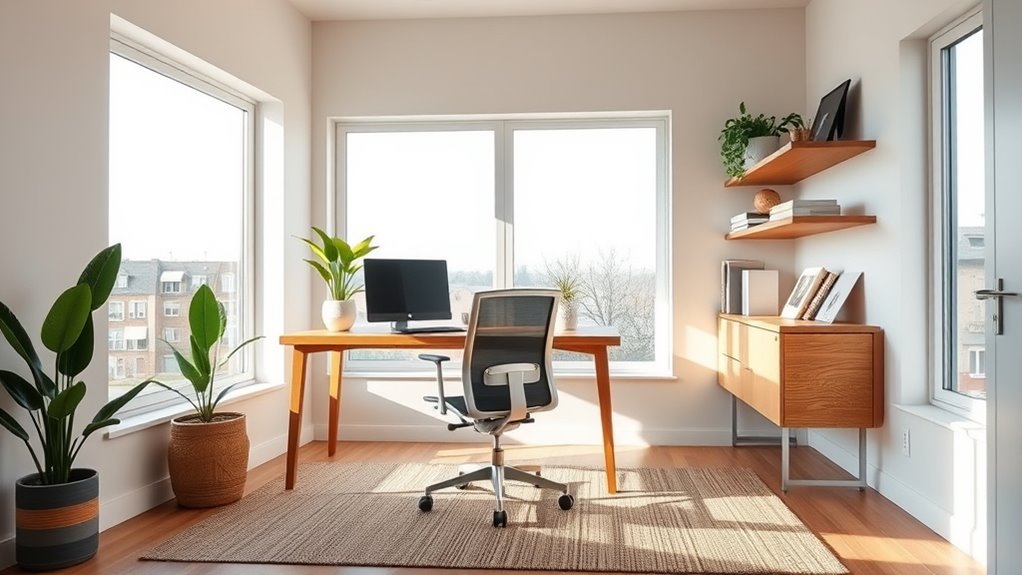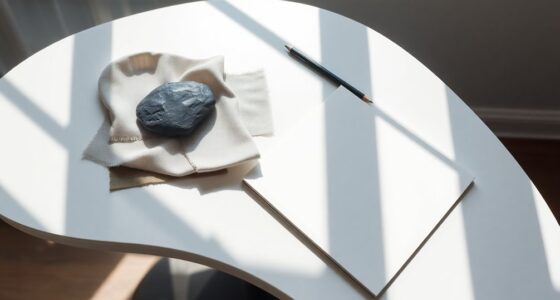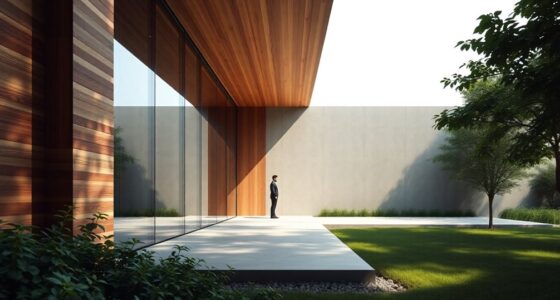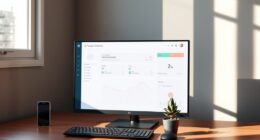To create a focused home office, assess your space to guarantee it fits your needs, keeping clutter out of sight with smart storage. Designate zones for different tasks, like deep work and meetings, and position your desk away from distractions. Choose ergonomic furniture and prioritize good lighting with calming decor to enhance comfort and concentration. For step-by-step tips on making your space work for you, explore the best layout strategies further.
Key Takeaways
- Create designated zones for focused work, meetings, and breaks to reduce distractions and improve productivity.
- Position desks away from high-traffic areas and noisy views to minimize visual and auditory distractions.
- Incorporate soundproofing and acoustic panels to enhance concentration and reduce ambient noise.
- Use ergonomic furniture and proper lighting to promote comfort and reduce physical strain during work.
- Keep the workspace organized with smart storage solutions and minimal decor to maintain a clutter-free environment.
Assessing Your Space and Needs
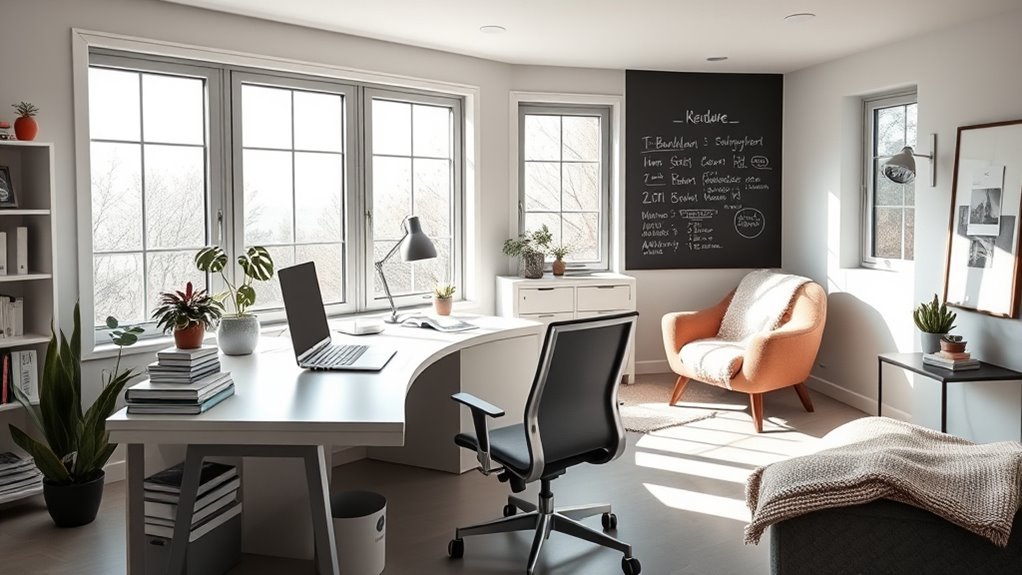
To effectively design a focused workspace, you first need to evaluate your current environment and identify your specific needs. Start by examining your space’s size and layout, considering how much room you require for your work essentials. Think about your storage solutions—do you need drawers, shelves, or cabinets to keep clutter at bay? This helps create an organized environment that minimizes distractions. Next, consider your preferred color schemes; calming tones like blues or neutrals can enhance concentration, while bright colors might energize you. Understanding your visual preferences and storage requirements allows you to tailor your workspace to support productivity. Additionally, incorporating Maximize Space and Organization strategies can further optimize your layout for efficiency. Being aware of projector technology features can also help you select equipment that complements your workspace setup without causing clutter or distraction. Incorporating vintage or rustic decor elements can add a personalized touch that makes your workspace more inviting and inspiring. Research indicates that AI tools can assist in optimizing home office designs by analyzing space utilization and suggesting layout improvements. By thoroughly assessing your space and needs, you’ll set a strong foundation for a functional, focused home office.
Creating Zones for Different Tasks

Establishing designated zones within your workspace helps you stay focused and manage different tasks efficiently. By creating specific areas for activities like deep work, meetings, or breaks, you reduce distractions and boost productivity. To separate these zones effectively, consider soundproofing strategies to minimize noise interference, especially for focused work. Incorporate smart storage solutions to keep each zone organized and clutter-free, making it easier to switch between tasks. For example:
- Quiet zones with soundproofing to block distractions
- Meeting areas with accessible storage for supplies
- Break zones that promote relaxation
- Task-specific spaces tailored to your workflow
Implementing zoning techniques can further optimize each area’s function and enhance your overall focus. Designing your office with clear zones ensures you can switch seamlessly between tasks, stay focused, and maintain a balanced work environment. Paying attention to spatial arrangement ensures each zone supports its intended purpose effectively.
Optimizing Furniture Placement for Concentration
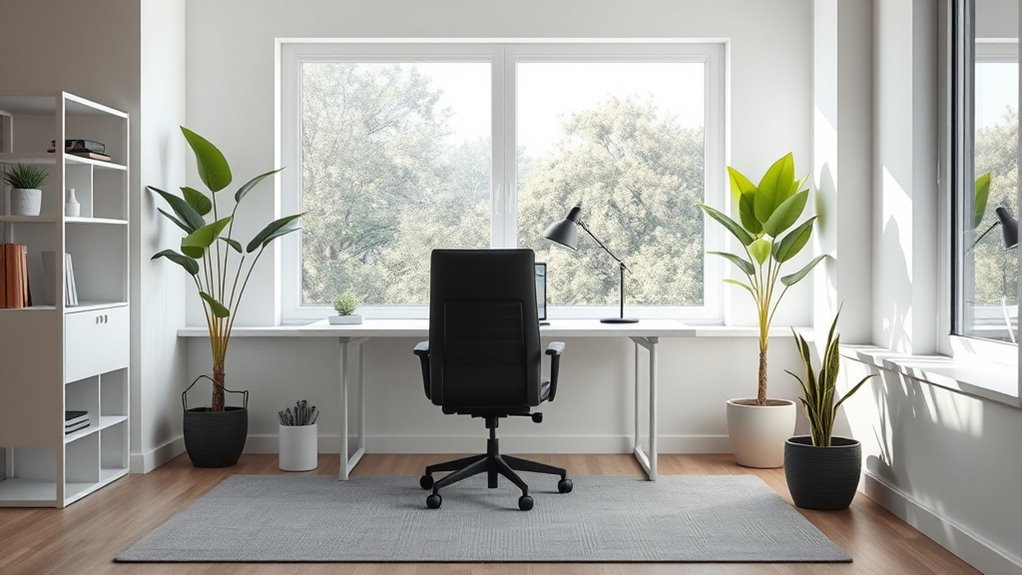
Strategic furniture placement can considerably enhance your ability to concentrate by reducing distractions and creating a sense of order. Position your desk to face away from high-traffic areas or windows with busy views, minimizing visual clutter. Use storage solutions like shelves or cabinets to keep supplies organized and out of sight, preventing clutter from stealing your focus. Choose calming color schemes—such as muted blues or neutral tones—that promote tranquility and mental clarity. Place essential items within easy reach, avoiding the need to get up frequently, which breaks concentration. Keep pathways clear and avoid overcrowding your space with unnecessary furniture. Incorporating ergonomic design principles can further support comfort and productivity during work hours. Paying attention to lighting conditions can also reduce eye strain and fatigue, thereby maintaining focus throughout the day. Recognizing the importance of dog breeds can also inspire a positive mindset and emotional balance, indirectly boosting your focus. By thoughtfully arranging your furniture, you create an environment that fosters focus, reduces stress, and boosts productivity during work hours.
Incorporating Ergonomics and Comfort
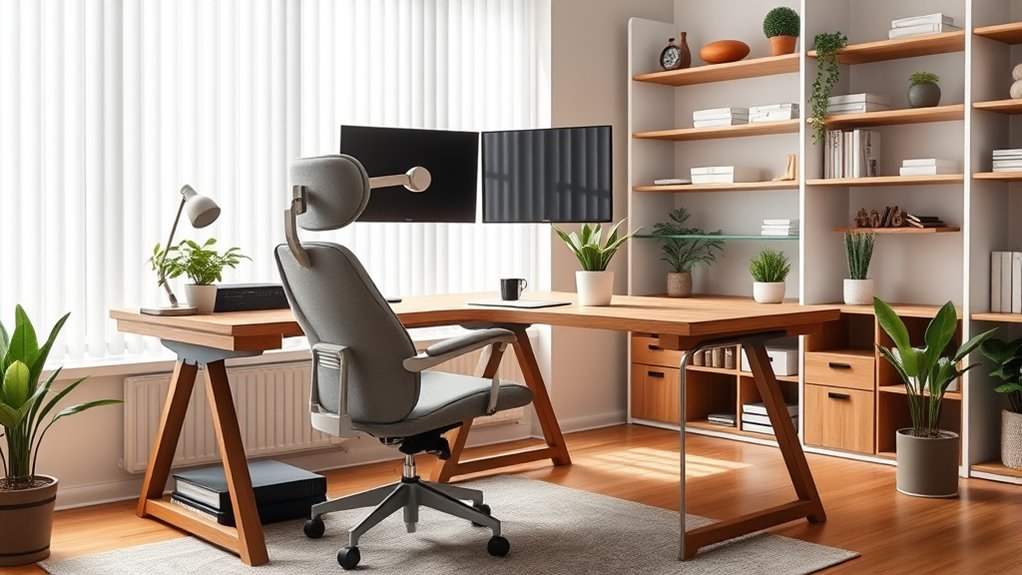
Incorporating ergonomics and comfort into your workspace is essential for maintaining focus and preventing fatigue. Choosing the right equipment can make a significant difference in your productivity and well-being. For example, a standing desk promotes movement and reduces strain from prolonged sitting, helping you stay alert. Acoustic panels can absorb noise, creating a quieter environment that minimizes distractions. Additionally, ergonomic chairs support proper posture, reducing back pain. Keep these tips in mind:
Prioritize ergonomic furniture and noise reduction for a healthier, more focused workspace.
- Use adjustable standing desks to vary your position throughout the day
- Install acoustic panels to dampen background noise
- Invest in ergonomic chairs that promote good posture
- Position monitors at eye level to prevent neck strain
- Incorporating AI-powered tools can further optimize your workspace by providing personalized ergonomic recommendations and productivity insights. Leveraging AI security technologies ensures that your data remains protected as you adopt new digital tools.
Prioritizing comfort and ergonomics helps you stay focused longer and work efficiently.
Enhancing Focus With Lighting and Decor

Good lighting and well-chosen decor can substantially boost your ability to focus. Ambient lighting, such as soft overhead lights or warm lamps, creates a calming environment that reduces eye strain and distractions. Avoid harsh, direct lighting that causes glare. Incorporate decorative accents like artwork, plants, or personal items to make your workspace inviting and inspiring. These touches can improve mood and help you stay engaged. Use lighting and decor intentionally to define your space and foster concentration. Keep clutter minimal, and select decor that promotes a sense of calm and order. By balancing functional lighting with thoughtful decorative accents, you create an environment that supports sustained focus and productivity throughout your workday. Incorporating decorative accents, such as artwork and plants, can also enhance the aesthetic appeal and create a more personalized workspace. Additionally, selecting decor that aligns with your home office environment can further boost your motivation and focus. Understanding how environmental factors influence concentration can help you design a more effective workspace.
Frequently Asked Questions
How Can I Reduce Noise Distractions in My Home Office?
To reduce noise distractions in your home office, you can implement soundproofing strategies like sealing gaps around doors and windows. Additionally, focus on acoustic panel placement—position panels on walls where sound reflections happen most. This helps absorb noise and keeps your workspace quieter. Combining these tactics creates a calmer environment, so you can concentrate better and stay productive without being disturbed by outside or household noise.
What Are Budget-Friendly Ways to Improve Focus Areas?
Ever wonder how you can boost focus without spending a fortune? You can create an effective focus area with affordable lighting, like desk lamps or string lights, to brighten your workspace. Plus, DIY decor such as painted canvases or repurposed items adds personality without breaking the bank. These simple, budget-friendly ideas help you stay motivated and productive, transforming your home office into a more inviting and focused environment.
How Do I Personalize My Workspace Without Clutter?
To personalize your workspace without clutter, start with simple personalization tips like adding meaningful decor or photos in designated areas. Keep clutter reduction in mind by regularly decluttering and using storage solutions to hide excess items. You can also use organizers to maintain a tidy space while showcasing personal touches. This balance helps create a workspace that reflects you, boosts motivation, and stays organized and focused.
What Plants Help Boost Concentration in a Home Office?
You can boost concentration in your home office by adding air purifying plants like snake plants, pothos, or ZZ plants. These low-maintenance greenery options not only improve air quality but also create a calming environment, helping you stay focused. Incorporate these easy-care plants into your workspace to enhance productivity without the hassle of constant upkeep, making your home office more inviting and conducive to work.
How Can I Manage Cable Organization Effectively?
Imagine you’re working on a project, but tangled cables keep distracting you. To improve focus, use cable management and organization tips like cable clips or sleeves to keep cords tidy and prevent clutter. You can also label cables for quick identification. By keeping cables organized, you reduce stress and create a cleaner workspace, helping you stay focused and efficient throughout your workday.
Conclusion
By evaluating your space and needs, creating designated zones, and optimizing furniture placement, you set the foundation for a productive home office. Incorporate ergonomic comfort and enhance focus with thoughtful lighting and decor. Prioritize organization, prioritize comfort, prioritize clarity—these elements work together to create an environment where you can focus, thrive, and work efficiently. When you design intentionally, you build a space that supports your goals, boosts your mood, and makes work feel less like a chore and more like a choice.
